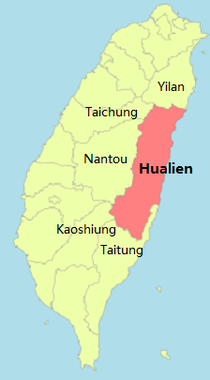
Brief information about Hualien
Hualien County is located on Taiwan eastern coast, facing Pacific Ocean to the east, Central Mountain Range to the west bordering Taichung City, Nantou County and Kaoshiung City, to the north Yilan County and Taitung County to the south.
Has the coast line of about 130km from north to south.
Total area of 4,628.57 sq.km. is the largest area of all counties in Taiwan.
Has a population of 333,392 people in Dec. 2014, ranked 17th of 22 counties and have a denisty of 71.7people per sq.km
Hualien county has 1 city (Hualien City), 2 urban townships (Fengling & Yuli) and 10 rural townships (Fengbin, Fuli, Gangfu, Jian, Ruisui, Shoufeng, Wanrong, Xincheng, Xiulin and Zhouxi).
Hualien County is located on Taiwan eastern coast, facing Pacific Ocean to the east, Central Mountain Range to the west bordering Taichung City, Nantou County and Kaoshiung City, to the north Yilan County and Taitung County to the south.
Has the coast line of about 130km from north to south.
Total area of 4,628.57 sq.km. is the largest area of all counties in Taiwan.
Has a population of 333,392 people in Dec. 2014, ranked 17th of 22 counties and have a denisty of 71.7people per sq.km
Hualien county has 1 city (Hualien City), 2 urban townships (Fengling & Yuli) and 10 rural townships (Fengbin, Fuli, Gangfu, Jian, Ruisui, Shoufeng, Wanrong, Xincheng, Xiulin and Zhouxi).
Must see places in Hualien
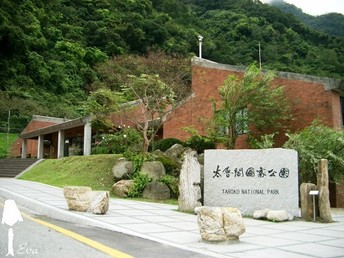
1. Taroko Vistor Centre / Taroko Terrace Trail 太魯閣遊客中心/太魯閣台地
If you come from Hualien city, this center should be your first place to visit before you process to the rest of the scenic area along Taiwan Provincial Highway line 8 within the Hualien County.
By visiting to this center you are able to get more information and knowledge of Taroko.
From the center is where the Taroko Terrace trail starts, and also let you have the first feel of the Taroko Area , the Terrace Trail is a comfortable trail to walk on an enjoyed the scenic view, see the layer of pebbles and sand accumulation that form the natural river banks, at times you may even spot birds, bees and other insects that live in this area too.
Come and view the 'art of god' .
If you come from Hualien city, this center should be your first place to visit before you process to the rest of the scenic area along Taiwan Provincial Highway line 8 within the Hualien County.
By visiting to this center you are able to get more information and knowledge of Taroko.
From the center is where the Taroko Terrace trail starts, and also let you have the first feel of the Taroko Area , the Terrace Trail is a comfortable trail to walk on an enjoyed the scenic view, see the layer of pebbles and sand accumulation that form the natural river banks, at times you may even spot birds, bees and other insects that live in this area too.
Come and view the 'art of god' .
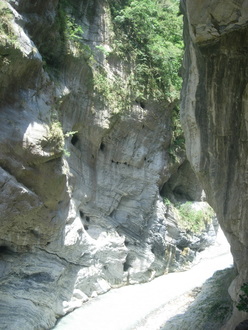
2. Swallow Grotto (Yanzikou) 燕子口
From the name "swallow" itself tell us that this place should somehow related to swallow. yes this marble cliff faces are with many small holes, this is where the swallow often forage and nest here, that why this place is name Swallow Grotto (Yanzhikou), but due to the increase of tourist you hardly see swallows nowadays, but still a must-see attractions in Taroko Gorge.
Anyway, at this trail you can enjoy and appreciate the beautiful terrain that wash out by the Liwu River, dramatic rock formations and potholes of these wonders of nature and the magnificent marble cliff.
From the name "swallow" itself tell us that this place should somehow related to swallow. yes this marble cliff faces are with many small holes, this is where the swallow often forage and nest here, that why this place is name Swallow Grotto (Yanzhikou), but due to the increase of tourist you hardly see swallows nowadays, but still a must-see attractions in Taroko Gorge.
Anyway, at this trail you can enjoy and appreciate the beautiful terrain that wash out by the Liwu River, dramatic rock formations and potholes of these wonders of nature and the magnificent marble cliff.
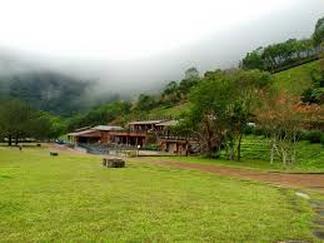
3. Buluowan Terrace 布洛灣 布洛湾
Buluowan is a terrace surrounded by a group of mountains, consists os an upper and lower terrace, because of thsi special terrain, therefore, you are able to hear echo when yo using or talk out loud.
The lower terrace of Buluowan is known as Buluowan Sevice Station, the service station provides tourist services and information.
The upper terrace is where you find lodging area runs by the aboriginal Taroko people.
Other than the above mention hardware of this terrace, if you are here in April and May of year you see lilies blossom and fresh air of the river valley.
Nice and wonderful place for a hide out.
Buluowan is a terrace surrounded by a group of mountains, consists os an upper and lower terrace, because of thsi special terrain, therefore, you are able to hear echo when yo using or talk out loud.
The lower terrace of Buluowan is known as Buluowan Sevice Station, the service station provides tourist services and information.
The upper terrace is where you find lodging area runs by the aboriginal Taroko people.
Other than the above mention hardware of this terrace, if you are here in April and May of year you see lilies blossom and fresh air of the river valley.
Nice and wonderful place for a hide out.
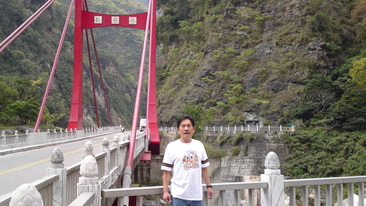
4. Cimu Bridge (Motherly Devotion Bridge) 慈母橋 慈母桥
A bridge painted in Red with marble stone lions on each ends and with marble lotus stones on two sides, below the bridge is where "Liwu" river and "Laoi" river meet, also known as "Heliu" meaning the converge (the junction of two rivers)
There is a pavilion on the side of the bridge, was built by the late President Chiang Kai-shek, in memory of his mother, Mrs. Wang.
And there is a rock beneath the bridge looks like a frog, on top of the rock there is a pavilion too, this pavilion looks like the crown on the frog and was built by late President Chiang Ching-kuo (son of President Chiang Kai-shek), in memory of his mother.
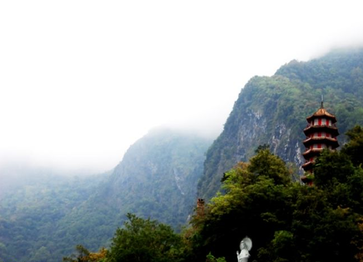
5. Tianxiang Recreational Area 天祥遊憩區 天祥游憩区
Tianxiang is a large river terrace recreational area in Taroko National Park, this multilayers river terrace was formed because of years of erosion.
This area has large parking space, tourist service station, Plum Garden, Tianfeng Pagoda, Giant Statute of Bodhisattva, Xiangde Temple, Restaurants, Post Office, Presbyterian Church, Youth Activity Center, Catholic Church and Hotel.
Tianxiang has beautiful scenery and pleasant weather, this is another magnificent landscape of the nature, is breathtaking.
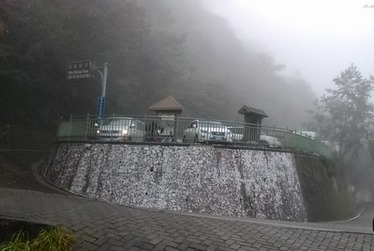
6. Bilu Sacred Tree 碧綠神木 碧绿神木
An attraction due to its age and size, the Bilu Sacred Tree is a 3,000 years old fir tree that stands about 50 meters high with a diameter of 3.5 meters.
The terrain around Bilu Sacred Tree is complex, plus temperature increases with altitude, therefore, around this area often crowned with clouds and mist, the location of Bilu Sacred Tree is about 2,150 meters above sea level.
Good and nice to enjoyed this heaven like environment.
An attraction due to its age and size, the Bilu Sacred Tree is a 3,000 years old fir tree that stands about 50 meters high with a diameter of 3.5 meters.
The terrain around Bilu Sacred Tree is complex, plus temperature increases with altitude, therefore, around this area often crowned with clouds and mist, the location of Bilu Sacred Tree is about 2,150 meters above sea level.
Good and nice to enjoyed this heaven like environment.

7. Guanyuan Park (Guanyuan Sea of Clouds) 關原雲海 关原云海
Guanyuan Park is at 2,370meters above sea level along Taiwan Provincial Highway Line 8, the spot where you view the beautiful sea of clouds (A sea of clouds is an overcast layer of clouds, viewed from above, with a relatively uniform top which shows undulations of very different lengths resembling waves)
The interesting thing is that there is a petrol kiosk next to this park and make the highest petrol kiosk in Taiwan.
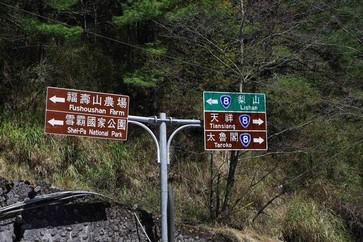
8. Dayuling 大禹嶺 大禹岭
2,565meters above sea level, the watershed of Liwu River and Dajia River and bordes the counties of Taichung, Nantou and Hualien. Here you see the highway splits into three roads, one leading to Hehuangshan, one to Lishan and the other to Taroko.
The scenery here is more of mountains, cloud and if you are lucky you will be able to appreciate snow on Hehuangshan during winter.
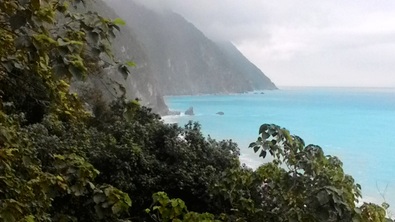
9. Qingshui Cliffs
Traveling along Taiwan Provincial Highway Line 9 (SuHua Highway) toward the north to Yilan and once you exit the Chongde Tunnel you will see a observation deck near to the road side, standing on the deck you see spectacular cliff facing the Pacific Ocean, is really a magnificent scene, these sheer cliffs of about 800meters' height that plunge straight into the blue ocean.
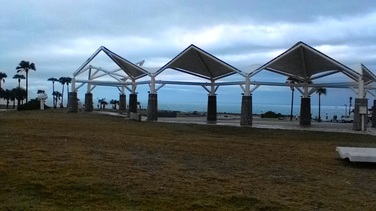
10. Qixingtan 七星潭
"Tan" in Chinese means lake, but this is not its name suggest, instead it is one of the most beautiful beaches in Taiwan.
Over here you get clear and board view of the blue sky meets an endless Pacific Ocean. The crescent shape beach is full of beautiful rounded pebbles, the open landscape in front of the beach let you feel real relaxing and refreshing.
Standing at the beach and behind you in the spectacular mountain area, at times you may see canopy of clouds seems to crown the mountains or snow on the mountain top.
"Tan" in Chinese means lake, but this is not its name suggest, instead it is one of the most beautiful beaches in Taiwan.
Over here you get clear and board view of the blue sky meets an endless Pacific Ocean. The crescent shape beach is full of beautiful rounded pebbles, the open landscape in front of the beach let you feel real relaxing and refreshing.
Standing at the beach and behind you in the spectacular mountain area, at times you may see canopy of clouds seems to crown the mountains or snow on the mountain top.
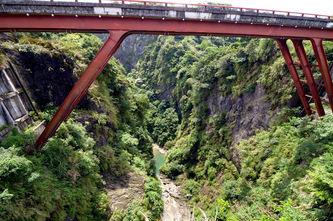
11. Fanshuliao 蕃薯寮
Offers views of 70meters deep and 50meters wide valley scenic spot that one should not miss.
A wide valley made up of accumulated sediment, and a narrow, vertical wall gorge which has been cut through the mountains by the relentless wearing action of the flowing water, looks like the Taroko Gorge.
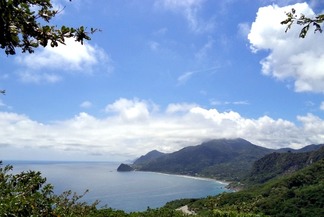
12. Baqi Viewing Deck 芭崎觀景區
One of the few highest points on the coastal highway (Hiangway 11).
Baqi has a great view of the unique features of the coastal landscape of the Pacific Coastal line.
From the viewing deck you look to the south there is beautiful beach, and that is Jiqi Bay or beach whcih is the only beach in Hualien and should be your next stop of visit.
Since it is only one of the resting area on Highway 11 within Hualien County, you find small stalls selling food and drinks by the aboriginal here.
One of the few highest points on the coastal highway (Hiangway 11).
Baqi has a great view of the unique features of the coastal landscape of the Pacific Coastal line.
From the viewing deck you look to the south there is beautiful beach, and that is Jiqi Bay or beach whcih is the only beach in Hualien and should be your next stop of visit.
Since it is only one of the resting area on Highway 11 within Hualien County, you find small stalls selling food and drinks by the aboriginal here.
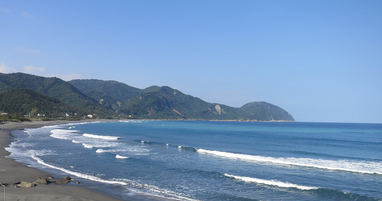
13. Jiqi Bay (Jici Bay) 磯崎灣
Has a 3km long beach, during high tide in winter sand is washed away that make the beach become black, and when summer comes the beach become a golden beach during low tide, this make the beach a great place for summer in the sea.
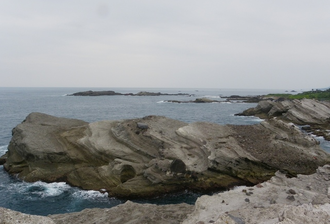
14. Shihtiping 石梯坪
A spectacular natural sculptured rocks lining up on the beach with irregular lengths whereby it looks like stone steps, this is where the name "Shitiping" derived. (Chinese translation of Shitiping means flat stone steps or stairs).
This wonderful sight was derived from the formation of volcanic rock worn by sea erosion was uplifted in layers.
A spectacular natural sculptured rocks lining up on the beach with irregular lengths whereby it looks like stone steps, this is where the name "Shitiping" derived. (Chinese translation of Shitiping means flat stone steps or stairs).
This wonderful sight was derived from the formation of volcanic rock worn by sea erosion was uplifted in layers.
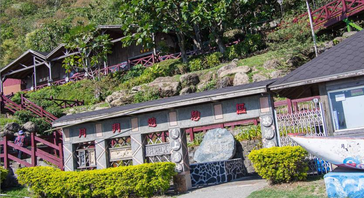
15. Yuedong (Moon Cave) 月洞
Yuedong, is a stalactite cave also known as Yuejing (Moon Well) the pure land (Holy Land) of the aboriginals.
This cave is with water inside, is about 80 meters above sea level and 800meters away from the coast, according to legend the water in the cave will rise and fall during a full moon or crescent. You travel in the cave by canoe operates by the aboriginals.
The cave is dark, stalactite everwhere with thousnads of bats hanging around, there are two routes in the cave, the left one about 50meters long and the right one has about 40 meters long.
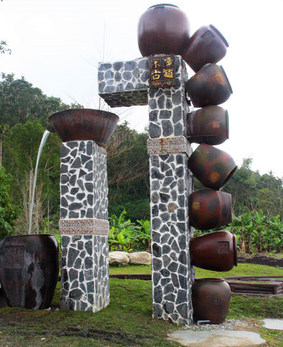
16. Mizhan Old Trail 米棧古道
Mizhan in Chinese means "rice warehouse", in the olden days' villagers from "Shuilian" used to carry rice on their backs (known as porter) to the Mizhan village on this only trails to Mizhan and gather all rice here, thereafter, they send their rice across the river or use the river to transport their rice to sell them to another part of the country.
The porters then become the only main transportation trade of this area and make this, one of the most significant cultural features of this trail.
Visiting to this place you have to be prepare to do a little tracking, because you have to track about 1.7km up to reach the 415meter above sea level to take a good view of the village, of course for people who do not like to go on tracking you may spend your time downhill to enjoyed the village life.
Mizhan in Chinese means "rice warehouse", in the olden days' villagers from "Shuilian" used to carry rice on their backs (known as porter) to the Mizhan village on this only trails to Mizhan and gather all rice here, thereafter, they send their rice across the river or use the river to transport their rice to sell them to another part of the country.
The porters then become the only main transportation trade of this area and make this, one of the most significant cultural features of this trail.
Visiting to this place you have to be prepare to do a little tracking, because you have to track about 1.7km up to reach the 415meter above sea level to take a good view of the village, of course for people who do not like to go on tracking you may spend your time downhill to enjoyed the village life.
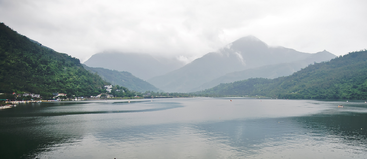
17. Liyu Lake (Carp Lake) 鯉魚潭
The largest lake in eastern Taiwan, about 20km away from Hualien City. Water in the lake comes from underground springs, therefore, the water is crystal clear all year round, other than enjoying the sceneries of the lake and the surrounding Liyu Mountain there are activities like, canoeing, boating, sailing on the lake or a bicycle tour to go round the lake.
There are also some trails for you to walk up to 600meter high area to view and enjoyed the forest bathing trip (in Japanese known as Shinrin-yoku) or Chinese Known as Senlin Bath.

18. Liushidanshan 六十石山
The famous Daylily blossoms areas in Hualien (there is one in Taitung too), during August to September you see the golden Daylily flowers covers up the land and is nice to be here during this period.
Even you miss the blossom season, the landscape is still attractive and promising, with the vast open sceneries will take your breath away.
Overlooking at the rice paddies and whole of the East Rift Valley from the top of the mountain, with the appealing and disappearing of some farm houses with wind blowing onto the farm land, gives you the taste of Europe, that is why this place has earned it's nicknamed, "Little Switzerland of Taiwan".
The famous Daylily blossoms areas in Hualien (there is one in Taitung too), during August to September you see the golden Daylily flowers covers up the land and is nice to be here during this period.
Even you miss the blossom season, the landscape is still attractive and promising, with the vast open sceneries will take your breath away.
Overlooking at the rice paddies and whole of the East Rift Valley from the top of the mountain, with the appealing and disappearing of some farm houses with wind blowing onto the farm land, gives you the taste of Europe, that is why this place has earned it's nicknamed, "Little Switzerland of Taiwan".
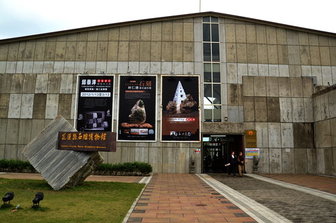
19. Hualien County Stone Scultural Museum 花蓮石雕博物館
Hualien has 90% of natural stone resources, the most stone sculpture production of the whole of Taiwan and earned its name of "stone counties". In this county you see everywhere, huge sculptured stones, especially in the park areas.
This museum is the only museum fully dedicated to the art of stone carving. The displayed inside and outside the exhibition hall is the best collections and works of the International Stone Sculpture Festival for the years.
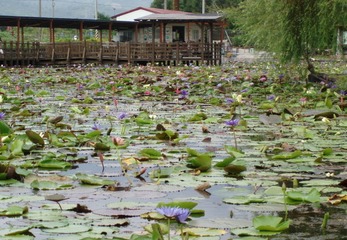
20. LianCheng Lotus Garden 蓮城蓮花湖
This garden has lotuses blooming all year round. Because the water in the pound maintain a water temperature of 20 degrees that give lotus a very suitable place to growth.
Other than viewing more than sixty varieties of lotus you can try out teas, wines, perfumes, biscuits, snacks and others goodies made from the beautiful aqua flower here by the owner of this garden.
This garden has lotuses blooming all year round. Because the water in the pound maintain a water temperature of 20 degrees that give lotus a very suitable place to growth.
Other than viewing more than sixty varieties of lotus you can try out teas, wines, perfumes, biscuits, snacks and others goodies made from the beautiful aqua flower here by the owner of this garden.
